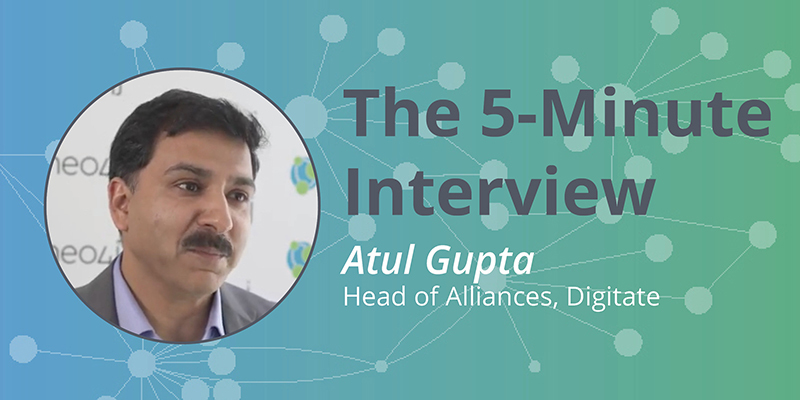“We didn’t realize there was something that could understand relationships, dependencies and interdependencies, and could be so easy to use as well,” said Atul Gupta, Head of Alliances at Digitate, a strategic business unit of Tata Consultancy Services (TCS).
Enterprise IT can be visualized as a connected set of nodes with various types of connections between them. These nodes and relationships form a graph which, if maintained in a traditional RDBMS, are slow to store and query.
The initial version of Digitate’s ignio used an RDBMS for storing models and data. The latest release of ignio called AIOps Cheetah was built on Neo4j. Neo4j helps ignio with the storage capacity, processing and query speeds required to deliver award-winning performance along with representing IT infrastructure naturally as a graph.
In this week’s five-minute interview (conducted at GraphTour 2019 in San Francisco), we spoke with Atul Gupta about the importance of context for AI Ops.
Tell us how Digitate is using Neo4j.
Atul Gupta: Digitate uses Neo4j as our graph database.
We offer an AI product and so, for us, context plays a key role. When you look at any AI product, behavior and context are extremely important.
While behavior is time-sensitive, context is much more static. For our context-building models, we use Neo4j.
Can you tell us about ignio?
Atul: ignio is a cognitive automation product. Think of any type of operations, be it IT operations, SAP operations, workload management or any other kind of operations that is human-intensive. You have an army of IT engineers in your data center who manage your IT. Now think of the same world without the IT engineers. ignio is an AI that can actually take care of that.
ignio learns context, manages alerts, gives you smart alerts and triggers, and provides smart recommendations. It doesn’t stop there; ignio can also take action, autonomously. And it shows your IT staff that your operations are up and running.
What made you choose Neo4j?
Atul: As I mentioned, context is very important to us. And when we looked at the whole problem, the moment our scale of nodes and relationships went beyond a million, there were not too many relational databases that could actually do that job.
And when we looked at the available technology, we saw the ease of working with Neo4j, the features it offers, and its availability and scalability. Looking at the user community, Neo4j is the market leader in this particular space and that’s why we went with Neo4j.
What have been the most surprising results you have seen from Neo4j?
Atul: I think the ease of using Neo4j and the kinds of results we achieved surprised us. That may be because we were used to relational databases and we didn’t realize there was something that could understand relationships, dependencies and interdependencies, and actually be so easy to use as well.
Is there a particular customer story you wish to highlight?
Atul: One of our customers had millions of batch jobs. And each batch job, especially in banking or in manufacturing, has many relationships and dependencies.
Neo4j enables us to connect all that information to pinpoint the probable cause of failure. We can also show what else would fail, in a cascading effect, if this job fails. That’s where a technology like Neo4j comes in handy for us.
What do you think is in store for the future of graphs?
Atul: Ours is a pure AI Ops product. And we certainly believe that the world is moving toward understanding the whole environment, the business functionality, the dependency of business on IT and mapping every kind of relationship and every component in that particular business.
The goal is to create a 360-degree view that shows, from the VMs to the host to the last possible network device, what I should focus on and how I can make things smarter. That’s where technologies like Neo4j play a key role. It has a great future in the AI Ops world.
Want to share about your Neo4j project in a future 5-Minute Interview? Drop us a line at content@neo4j.com
Download this white paper, The Top 5 Use Cases of Graph Databases, and discover how to tap into the power of graphs for the connected enterprise.
Read the White Paper




